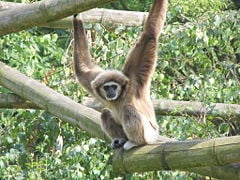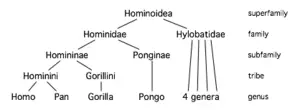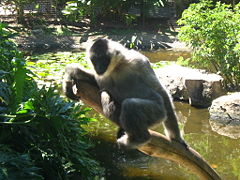Difference between revisions of "Gibbon" - New World Encyclopedia
Rick Swarts (talk | contribs) (Added article from Wikipedia and credit/category tags) |
Rick Swarts (talk | contribs) |
||
| Line 22: | Line 22: | ||
}} | }} | ||
| − | '''Gibbons''' | + | '''Gibbons''' is any member of [[ape]]s that are grouped in the [[family (biology)|family]] '''Hylobatidae'''. |
| + | |||
| + | |||
| + | found in the forests of SE Asia. | ||
| + | |||
| + | known as lesser apes, in contrast to the other major division of Hylobatidae, the greater apes, | ||
| + | most highly adapted of the apes to arboreal life. | ||
| + | |||
| + | |||
| + | Orangutans are [[ape]]s in the family Hominidae and superfamily Hominoidea (Order [[Primate]]s). Members of the Hominidae family, which include the [[gorilla]]s, [[chimpanzee]]s, orangutans, and [[human]]s, are known as the "great apes," while all other apes belong to the family Hylobatidae and are known as the "lesser apes" (gibbons). | ||
| + | |||
| + | In another taxonomic scheme, historically popular, the orangutans, chimpanzees, and gorillas are placed as members of the Pongidae family, while humans are separated into the Hominidae family. Some researchers place gorillas and chimpanzees (and the related bonobos) into the Panidae family, while orangutans remain in the Pongidae family, and humans in the Hominidae family. | ||
| + | |||
| + | |||
| + | |||
| + | The family is divided into four genera based on their [[diploid]] [[chromosome]] number: ''[[Hylobates]]'' (44), ''[[Hoolock]]'' (38), ''[[Nomascus]]'' (52), and ''[[Symphalangus]]'' (50).<ref name=Mootnick/><ref name=Geissmann>{{cite web | last = Geissmann | first = Thomas | title = Gibbon Systematics and Species Identification | url = http://gibbons.de/main/system/intro.html | accessdate = 2006-04-13}}</ref> They occur in tropical and subtropical rainforests from northeast [[India]] to [[Indonesia]] and north to southern [[China]], including the islands of [[Sumatra]], [[Borneo]] and [[Java (island)|Java]]. The extinct ''[[Bunopithecus sericus]]'' is an extinct gibbon or gibbon-like ape which, until recently, was thought to be closely related to the Hoolock gibbons.<ref name=Mootnick/> | ||
Also called the '''lesser apes''', gibbons differ from [[great ape]]s ([[chimpanzee]]s, [[gorilla]]s, [[orangutan]]s and [[human]]s) in being smaller, pair-bonded, in not making nests, and in certain anatomical details in which they superficially more closely resemble [[monkey]]s than the great apes do. Gibbons are masters of their primary mode of locomotion, [[brachiation]], swinging from branch to branch distances of up to 15 m (50 ft), at speeds as much as 56 km/h (35 mph). They can also make leaps of up to 8 m (27 ft), and walk bipedally with their arms raised for balance. | Also called the '''lesser apes''', gibbons differ from [[great ape]]s ([[chimpanzee]]s, [[gorilla]]s, [[orangutan]]s and [[human]]s) in being smaller, pair-bonded, in not making nests, and in certain anatomical details in which they superficially more closely resemble [[monkey]]s than the great apes do. Gibbons are masters of their primary mode of locomotion, [[brachiation]], swinging from branch to branch distances of up to 15 m (50 ft), at speeds as much as 56 km/h (35 mph). They can also make leaps of up to 8 m (27 ft), and walk bipedally with their arms raised for balance. | ||
Revision as of 14:48, 12 March 2007
| Gibbons[1][2] | ||||||||||||
|---|---|---|---|---|---|---|---|---|---|---|---|---|
 Lar Gibbon (Hylobates lar)
| ||||||||||||
| Scientific classification | ||||||||||||
| ||||||||||||
|
Hylobates |
Gibbons is any member of apes that are grouped in the family Hylobatidae.
found in the forests of SE Asia.
known as lesser apes, in contrast to the other major division of Hylobatidae, the greater apes, most highly adapted of the apes to arboreal life.
Orangutans are apes in the family Hominidae and superfamily Hominoidea (Order Primates). Members of the Hominidae family, which include the gorillas, chimpanzees, orangutans, and humans, are known as the "great apes," while all other apes belong to the family Hylobatidae and are known as the "lesser apes" (gibbons).
In another taxonomic scheme, historically popular, the orangutans, chimpanzees, and gorillas are placed as members of the Pongidae family, while humans are separated into the Hominidae family. Some researchers place gorillas and chimpanzees (and the related bonobos) into the Panidae family, while orangutans remain in the Pongidae family, and humans in the Hominidae family.
The family is divided into four genera based on their diploid chromosome number: Hylobates (44), Hoolock (38), Nomascus (52), and Symphalangus (50).[2][3] They occur in tropical and subtropical rainforests from northeast India to Indonesia and north to southern China, including the islands of Sumatra, Borneo and Java. The extinct Bunopithecus sericus is an extinct gibbon or gibbon-like ape which, until recently, was thought to be closely related to the Hoolock gibbons.[2]
Also called the lesser apes, gibbons differ from great apes (chimpanzees, gorillas, orangutans and humans) in being smaller, pair-bonded, in not making nests, and in certain anatomical details in which they superficially more closely resemble monkeys than the great apes do. Gibbons are masters of their primary mode of locomotion, brachiation, swinging from branch to branch distances of up to 15 m (50 ft), at speeds as much as 56 km/h (35 mph). They can also make leaps of up to 8 m (27 ft), and walk bipedally with their arms raised for balance.
One unique aspect of gibbon physiology is that the wrist is composed of a ball and socket joint, allowing for biaxial movement. This greatly reduces the amount of energy needed in the upper arm and torso, while also reducing stress on the shoulder joint. They also have long hands and feet, with a deep cleft between the first and second digits of their hands. Their fur is usually black, gray, or brownish, often with white markings on hands, feet, and face. Some species have an enlarged throat sac, which inflates and serves as a resonating chamber when the animals call. This structure is enormous in a few species, equalling the size of the animal's head.
Gibbon skulls resemble those of the great apes, with very short rostra, enlarged braincases, and large orbits that face forward. Gibbons have the typical nose of catarrhine primates with nostrils that are close together and face forward and slightly downward. They lack cheek pouches and their stomach is not sacculated. Their teeth also are similar to the great apes, with molars that are bunodont and lack lophs. The upper molars usually have a cingulum, which is sometimes large. The canines are prominent but not sexually dimorphic. The dental formula is:
| Dentition |
|---|
| 2, 1, 2, 3 |
| 2, 1, 2, 3 |
Gibbons are social animals. Strongly territorial, gibbons defend their boundaries with vigorous visual and vocal displays. The vocal element, which can often be heard for distances of up to 1 km, consists of a duet between a mated pair, their young sometimes joining in. In most species, males, and in some, females as well, sing solos that attract mates as well as advertise their territory.[4] The songs can make them an easy find for poachers who engage in the illegal wildlife trade and in sales of body parts for use in traditional medicine.
Most species are threatened or endangered, most importantly from degradation or loss of their forest habitat. Gibbon species include the Siamang, the White-handed or Lar Gibbon, and the hoolock gibbons. The Siamang, which is the largest of the 13 species, is distinguished by having two fingers on each hand stuck together, hence the generic and species names Symphalangus and syndactylus.
Classification
- Family Hylobatidae: gibbons[1][3]
- Genus Hylobates
- Lar Gibbon or White-handed Gibbon, Hylobates lar
- Malaysian Lar Gibbon, Hylobates lar lar
- Carpenter's Lar Gibbon, Hylobates lar carpenteri
- Central Lar Gibbon, Hylobates lar entelloides
- Sumatran Lar Gibbon, Hylobates lar vestitus
- Yunnan Lar Gibbon, Hylobates lar yunnanensis
- Agile Gibbon or Black-handed Gibbon, Hylobates agilis
- Mountain Agile Gibbon, Hylobates agilis agilis
- Bornean White-bearded Gibbon, Hylobates agilis albibarbis
- Lowland Agile Gibbon, Hylobates agilis unko
- Müller's Bornean Gibbon, Hylobates muelleri
- Müller's Gray Gibbon, Hylobates muelleri muelleri
- Abbott's Gray Gibbon, Hylobates muelleri abbotti
- Northern Gray Gibbon, Hylobates muelleri funereus
- Silvery Gibbon, Hylobates moloch
- Western Silvery Gibbon or Western Javan Gibbon, Hylobates moloch moloch
- Eastern Silvery Gibbon or Central Javan Gibbon, Hylobates moloch pongoalsoni
- Pileated Gibbon or Capped Gibbon, Hylobates pileatus
- Kloss's Gibbon or Mentawai Gibbon or Bilou, Hylobates klossii
- Lar Gibbon or White-handed Gibbon, Hylobates lar
- Genus Hoolock
- Western Hoolock Gibbon, Hoolock hoolock
- Eastern Hoolock Gibbon, Hoolock leuconedys
- Genus Symphalangus
- Siamang, Symphalangus syndactylus
- Genus Nomascus
- Concolor or Black Crested Gibbon, Nomascus concolor
- Nomascus concolor concolor
- Nomascus concolor lu
- Nomascus concolor jingdongensis
- Nomascus concolor furvogaster
- Eastern Black Crested Gibbon, Nomascus nasutus
- Cao Vit Gibbon, Nomascus nasutus nasutus
- Hainan Gibbon, Nomascus nasutus hainanus
- White-cheeked Crested Gibbon, Nomascus leucogenys
- Northern White-cheeked Crested Gibbon, Nomascus leucogenys leucogenys
- Southern White-cheeked Crested Gibbon, Nomascus leucogenys siki
- Yellow-cheeked Gibbon, Nomascus gabriellae
- Concolor or Black Crested Gibbon, Nomascus concolor
- Genus Hylobates
Reference
- ↑ 1.0 1.1 C. Groves, "Order Primates," "Order Monotremata," (and select other orders). Page(s) 178-181 in D. E. Wilson and D. M. Reeder, eds., Mammal Species of the World, 3rd edition, Johns Hopkins University Press (2005). ISBN 0801882214.
- ↑ 2.0 2.1 2.2 Mootnick, A. and Groves, C. P. (2005). A new generic name for the hoolock gibbon (Hylobatidae). International Journal of Primatology (26): 971-976.
- ↑ 3.0 3.1 Geissmann, Thomas. Gibbon Systematics and Species Identification. Retrieved 2006-04-13.
- ↑ Clarke, E, et al. (2006). The Syntax and Meaning of Wild Gibbon Songs. Retrieved 2007-01-18.
External links
Credits
New World Encyclopedia writers and editors rewrote and completed the Wikipedia article in accordance with New World Encyclopedia standards. This article abides by terms of the Creative Commons CC-by-sa 3.0 License (CC-by-sa), which may be used and disseminated with proper attribution. Credit is due under the terms of this license that can reference both the New World Encyclopedia contributors and the selfless volunteer contributors of the Wikimedia Foundation. To cite this article click here for a list of acceptable citing formats.The history of earlier contributions by wikipedians is accessible to researchers here:
The history of this article since it was imported to New World Encyclopedia:
Note: Some restrictions may apply to use of individual images which are separately licensed.



